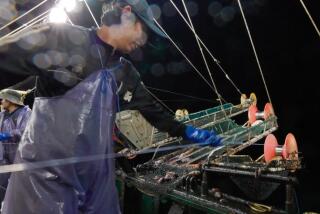U.S. Trawler Fleet Association Sues Over Rule Change
- Share via
SEATTLE — Officials of the nation’s huge factory trawler fleet warned Monday that new U.S. rules governing the billion-dollar Bering Sea bottomfish catch could increase Japan’s grip on the lucrative market.
The American Factory Trawler Assn. filed suit Friday in U.S. District Court against the Department of Commerce challenging the new rules.
The regulations went into effect Monday, the opening day of the summer season for the plentiful fish known as pollock.
The rules, for the first time, guarantee that Alaska onshore processing plants get a fixed share of the 1.4 million metric tons--more than 3 billion pounds--of pollock to be caught from the world’s largest fishery this year.
This year, for example, the largely Japanese-controlled onshore plants will be allocated 35% of the catch under regulations set by the North Pacific Fishery Management Council and approved by the Commerce Department.
Last year, just 25% of the groundfish--which are sold mostly to a huge Japanese market for processed fish known as surimi--were processed on shore, and trawler owners fear onshore allocation may rise to 45% within two years.
The trawlers association argues that the offshore fleet may lose $714 million by the end of 1995 and that there will be a loss of overall value-added in processing in the United States because on-shore benefits will be just $540 million.
“It is important that people recognize that it’s another example of competitive Japanese business practices,” said Robert Morgan, AFTA president and part owner of the trawling company Oceantrawl Inc.
“They (Japanese firms) now control the market, and they also control production,” he said. “The insult is that they’re using it on a resource that belongs to the United States.”
Onshore advocates counter that the land-based processing gives more back to the state of Alaska and that the Seattle-based fleet of more than four dozen factory trawlers also contains significant foreign and Japanese ownership.
For example, Japan’s Nippon Suisan Inc owns a major stake in Arctic Alaska Fisheries Corp, the only self-standing U.S. fishing concern listed on the New York Stock Exchange, while also being one of two top owners of Alaska onshore processing.
Fishery experts can agree on one central issue in the dispute: There is currently too much expensive equipment chasing too few fish in a fishery so immense its exact size cannot be accurately counted.
In fact, the groundfish market was actually pioneered by Japanese vessels and other foreign fleets beginning in the 1950s. Japan is also the primary market, where the codlike fish is processed into foods such as artificial crab.
The 1976 Magnuson Act sought to Americanize the market by extending the U.S. fishery management zone 200 miles and requiring majority U.S. ownership of fishing vessels.
More to Read
Sign up for Essential California
The most important California stories and recommendations in your inbox every morning.
You may occasionally receive promotional content from the Los Angeles Times.









